Chapter 11. Taking Time Out with Windows Vista Games
In This Chapter:
- Learn about Windows Free Games
- Master Solitaire
- Tread carefully with Minesweeper
- While away free time with FreeCell
- Enjoy a fast-paced game of Spider Solitaire
- Play Hearts against three imaginary players
- Battle your computer at Chess Titans
- Discover the Orient with Mahjong
- Teach your kids with Purble Place
- Set parental controls for games
- Understand the Games Explorer window
Many people use Windows Vista to help them get their work done. Many use Windows Vista to help them run the latest games. Many do both!
This chapter gives you somewhat of a time out from learning the aspects of Windows Vista because it focuses on gaming. Some games come with Vista and although you might have played them before, Vista has given them an attractive makeover. In addition, Vista makes it possible to more easily organize all the games you install on your computer, providing you with access to all your computer’s games from one location, even if they reside in separate locations around your computer (as they often do).
All work and no play makes Jane and John dull people...take a breather and learn how you can turn an idle ten minutes of downtime into some enjoyable brain calisthenics.
The Games Vista Supplies
Open your Start menu, click the Games entry in your Start menu’s right pane and you’ll see the games that Vista supplies in a window (see Figure 11.1). For users of previous Windows operating systems, Vista’s list of games will generally be familiar, but you’ll see a few newcomers that you haven’t seen before. When you select a game, its computer performance recommended rating appears along with the current computer’s rating, so you’ll know if the game will run sluggishly or efficiently.
Figure 11.1. Vista offers a few games to while away your idle time.
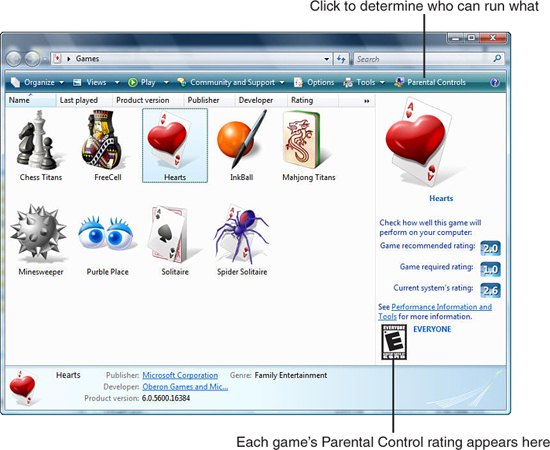
The following sections quickly run through some of Vista’s games and explain how to run and play them. They are intended to provide you with a basic overview, as opposed to detailed instruction guides.
By the Way
As you click to select each game in the Games window, you’ll see a rating in the lower-left corner of the window. You can set parental controls to keep certain users from accessing games of a particular rating if you want to do so. The “Setting Game Parental Controls” section later in this chapter explains how to control user access to games.
The Old Standby: Windows Solitaire
Solitaire has been around since some of the earliest versions of Windows and Vista didn’t buck the trend. Solitaire is fun, doesn’t require intensive mental alertness, which makes for a nice time-out during the day. Solitaire also offers a benefit in that people getting used to a new mouse or trackball find that playing a few rounds of Solitaire gets them familiar with the mouse quicker than most other means.
To start Solitaire, double-click the Solitaire icon in your Games window. Vista runs the Solitaire game and you’ll see the Solitaire window that looks something like the one in Figure 11.2. Vista changed the look to make the game more visually and audibly appealing than it has been for more than a decade.
Figure 11.2. The Solitaire game mimics that with real cards.
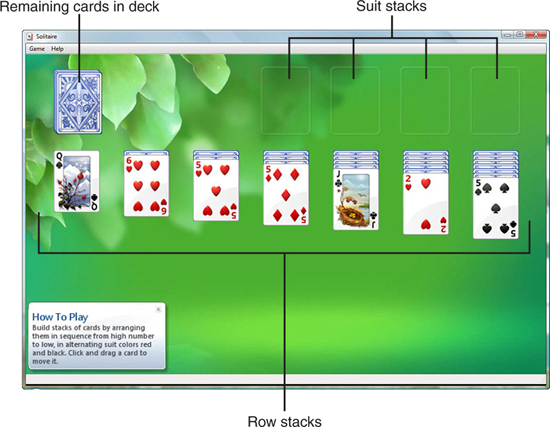
By the Way
This chapter spends a little more time explaining Solitaire than the rest of the games because Solitaire is by far the most-played of all the Windows games.
The purpose of Solitaire is to place all the cards in the four blank areas in the upper-right area of the window. These four stacks are called suit stacks because each area will eventually hold a stack of cards from the same suit.
You must build the suit stacks from Ace (the low card) to the King (the high card). After you’ve sent all 52 cards from the rest of the screen to the suit stacks, you win the game and see an animated card dance. Winning is a challenge and requires both skill and luck.
Did you Know?
You can change the pictures shown on the cards as well as Solitaire’s background image. Select Game, Change Appearance to display the Change Appearance window shown in Figure 11.3. Select a different picture and click OK to change to that deck and background. You can change either the deck or the background in the middle of a game without affecting the game’s status.
Figure 11.3. You can change the cards or background at any time during play.

If an Ace fully appears anywhere on the screen without being partially covered by one or more other cards, at any time, you can double-click that Ace to send the Ace to start a new suit stack. After you send an Ace, you can send a two, three, and so on until you build the entire suit in each stack. Whenever you see the next card from any of the suit stacks, you can double-click that card to put the card on the stack. If there is no Ace showing, you cannot place a card on a suit stack yet. You’ll have to begin rearranging and displaying cards in the lower portion of the screen to find cards to send to the suit stack.
Did you Know?
You can also drag the card from the lower area of the screen to the suit stack. After playing Solitaire for a while, you’ll be a pro at dragging with your mouse.
Before building a suit stack, you have to find cards on the screen that go there. The seven stacks of cards, called the row stacks, that you see in the center of the screen build downward. Row stacks are made from high cards to low cards and alternate from red to black. In other words, you always can place a red 8 on a black 9 and you can always place a black Queen on a red King.
If you can drag-and-drop a card from any of the row stacks onto another stack, you should do so. For example, the 10 of hearts (a red card) from the bottom of one row stack can be dragged onto a jack of spades (a black card) on the bottom of another stack. Dragging such a card frees up the card beneath the stack that originally held the 10 of hearts for use elsewhere.
On the back of the row stacks are cards that are hidden and you see only the card backs. When you move all the shown cards from a row stack, Solitaire turns over the card that’s on top of the row stack and makes that card available for play.
Did you Know?
You can move more than one card from one row stack to another. For example, if several cards on a row stack appear with descending ranks and alternating colors, you can move all those cards to another stack if the destination stack is a card that works with that group.
After you’ve moved all the cards possible among the row stacks, you’ll have to deal from the deck in the upper-left corner that holds all the cards left in the deck that don’t appear elsewhere in the window. Click the deck to deal the cards from that stack.
Watch Out!
Solitaire always deals three cards at a time from the deck, as is the standard Solitaire rule. You can change the number of cards dealt through the Game, Options menu if you want to make the game more or less difficult.
If you can place the card showing on the top of the three dealt cards onto a suit stack or a row stack, you can drag the card to that location. If you can do nothing with the dealt card, you’ll have to deal again. After you deal all the cards, you can deal again by clicking the deal stack twice. Solitaire monitors all your moves to ensure that you don’t place the wrong card somewhere. If you attempt to move a card where it does not belong, Solitaire will move the card back.
If you run out of moves and can do nothing further with the cards you have left, Solitaire tells you that in a dialog box and offers to undo the last move you made or let you quit the game.
The game continues until you run through all the dealt cards without being able to drag one to another stack. You win if you successfully build all four suit stacks.
Search and Destroy with Minesweeper
The goal of Minesweeper is simple. You set out through a minefield trying to locate all the mines without getting blown up.
Did you Know?
Minesweeper is a fast game to play. Therefore, if you want something to do while waiting on hold, you can play a quick round to pass the time.
Start Minesweeper by double-clicking its icon in the Games window. Your Minesweeper window will look something like the one in Figure 11.4.
Figure 11.4. Muster your courage to traverse the minefield.
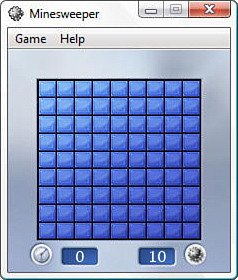
For such a simple game, Minesweeper contains several options that you can change. Choose your level of play by displaying the Game menu and selecting Beginner, Intermediate, or Expert. Each level of play determines the starting mine field size and the number of mines hidden in the field. The beginning player (the default) gets an 8-by-8 grid with 10 hidden mines. The intermediate player gets a larger minefield in 16-by-16 grid with 40 hidden mines. The expert player gets a 16-by-30 grid with 99 hidden mines. (You can customize the height, width, and number of hidden mines in each level by typing new numbers in the Options window.)
When you first load Minesweeper, Vista starts a new game. Unless you want to change an option, you can begin playing immediately. Your job is to click squares on the minefield grid to try to locate mines hidden under some of the squares. If you click on any square with a mine, you blow up and the game ends there. Your first click (and possibly some thereafter) is just a guess as to whether a mine is hidden there or not. After you click one square (without landing on a mine), you can begin to use logic to determine which remaining squares you can successfully click on. You win if you click to reveal all squares without mines.
The thing that appears when you click a square determines what happens next:
- If a number appears when you click a square, that number represents the number of mines that appear in the eight connecting boxes that surround the square. For example, if you click on a square and the number 2 shows on that square (instead of a mine blowing you up), two of the eight squares around that one contains mines and 6 do not.
- If a blank appears under a square, the blank indicates there are no surrounding mines. In addition, Minesweeper clears all the squares showing either more blank squares or numbers for clues to the rest of the minefield. A mine never appears in the squares cleared by Minesweeper when you land on a blank square.
Every game is different, so you cannot follow along with this example exactly. Nevertheless, consider what happens if, after clicking the upper-left corner square, the minefield in Figure 11.5 appears.
Figure 11.5. One click, especially in a corner, tells you a lot about the surrounding squares in the minefield.
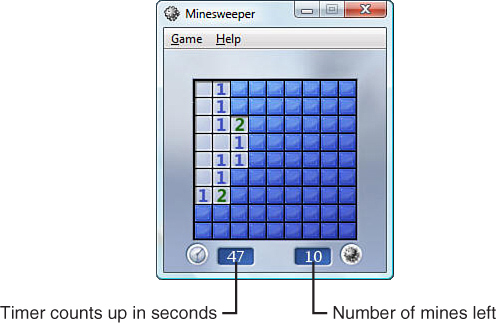
The click over the upper-left square produced lots of helpful information. In addition, none of the upper-left corner’s surrounding squares had mines on them. Therefore, Minesweeper automatically blanked those surrounding squares as well as additional squares that had either numbers or blanks.
For those squares where a number 1 appears, only one mine touches that square. Where a 2 appears, two mines touch that square somewhere on one of the eight sides. You continue playing, using deductive logic to uncover squares, with the numbers on top of the squares to guide you. When you suspect that a mine exists under a square, right-click that square to flag it as a mine and don’t click that square again. As you progress, the numbers and blank squares give you information to help pinpoint where some or possibly all the mines are hidden.
When you successfully right-click over all hidden mines to flag them without getting blown up, the game displays a Game Won window and shows your time.
FreeCell
FreeCell has a loyal following as it offers a different twist on the more traditional Solitaire game. At the end of 2005, NBC’s comedy The Office discussed FreeCell to the delight of the many players who love the game. When you first start FreeCell, you see eight stacks of cards, as shown in Figure 11.6.
Figure 11.6. FreeCell is based on Solitaire’s concept.
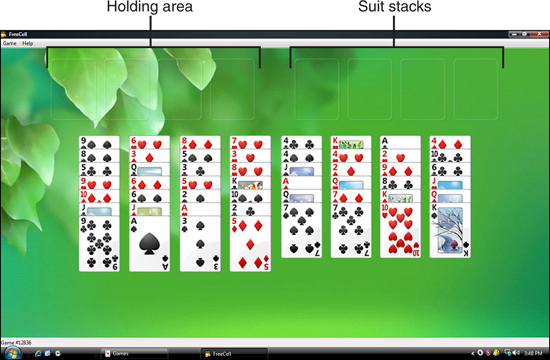
FreeCell contains a suit stack area in the upper-right corner just as Solitaire did and the goal is to send all cards to that suit stack. Whenever an Ace appears at the bottom of any of the eight stacks, you can drag that Ace to the suit stack to begin building that suit’s stack and eliminating cards from the area below. Depending on your skill, you might run out of legal moves and not be able to finish with a successful win.
By the Way
It’s said that every game in FreeCell is beatable. Your author certainly hasn’t been able to prove that as true!
Although the cards in the eight stacks first appear randomly, it’s your job to drag them into descending stacks of alternating colors not unlike Solitaire. You can drag from one to four cards to the holding area in the upper-left corner to move them out of the way while you arrange the bottom stacks. When you first begin, if no Ace appears at the bottom of any of the eight stacks, you’ll need to send one or more cards to the holding area in the upper-left corner and rearrange some cards onto other stacks to uncover an Ace to send it to the holding area. Once an Ace is there, you then work on uncovering that suit’s deuce (the 2 card) and sending it to the suit stack, and so on.
Figure 11.7 shows a game in progress. Both Aces remaining on the cards below are difficult to get to because they are so deep in the rows, so begin uncovering those rows as best you can to reveal the Aces.
Figure 11.7. Keep trying to get to the low cards first to form your suit stacks.

If this seems confusing, it’s because FreeCell is relatively easy to play, but trying to keep track of your potential moves adds an engaging layer of complexity. For anyone who enjoys Solitaire, however, you’ll see that FreeCell produces a little more action and is beatable more often than regular Solitaire is.
A Quick Glance at Spider Solitaire
Spider Solitaire seems to be an even more convoluted Solitaire game than FreeCell. The goal, as usual, is to eliminate the cards from the playing field as quickly as possible. At its default level, beginning, you only have to worry about rank because alternating suits aren’t part of the level. You get only two decks of spades to move. As you increase the playing difficulty in the game’s Options window, you can require that you work with two suits or all four.
When you start Spider Solitaire, you see 10 columns of 5 or 6 cards with the top card showing face up. As shown in Figure 11.8, Spider Solitaire uses two sets of cards so you’ll see two 6 of spades in the game, two King of spades, and two of every other spade (at the beginning level).
Figure 11.8. When you create a full run of cards from King down to Ace, the game removes all those cards from play for you.
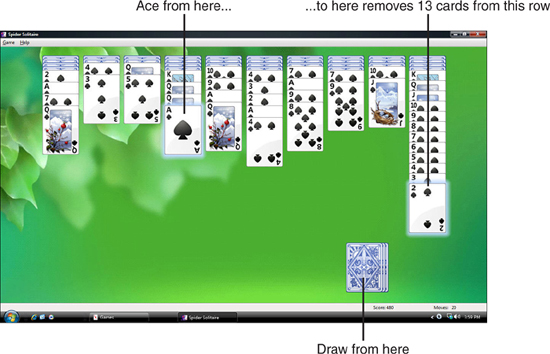
The goal is to move cards until you can complete a full run from King down to Ace using the same suit. Keep moving cards from high to low until you can form a complete run. In Figure 11.8, the tenth column is almost ready to lose 13 cards, which is good. After you drag column 4’s Ace to the 2 at the bottom of column 10, the game removes all 13 cards from the King down to the Ace, so you have fewer cards to manage.
If you can do nothing further with the cards in the columns—meaning you’ve moved as many cards as possible and have no more legal moves—click the rest of the deck in the lower-right corner. Spider Solitaire deals ten cards from the deck and places one on the bottom of each stack and you can again try to form a complete ranked column to eliminate.
Eliminate all the cards and you win the game. Of the three Vista Solitaire games, Spider Solitaire is both the easiest to win (at its beginning level) and the most difficult to win (when having to match all four suits in both decks).
Play Three Imaginary Players in a Game of Hearts
The Hearts game is intended for four players, unlike the other card games in Vista. When you start the game, you’re dealt your cards and the other three players’ cards are hidden from you (but each of them sees his or her own cards and not yours), as shown in Figure 11.9. The computer simulates the other three players.
Figure 11.9. Hearts is a multiplayer card game.
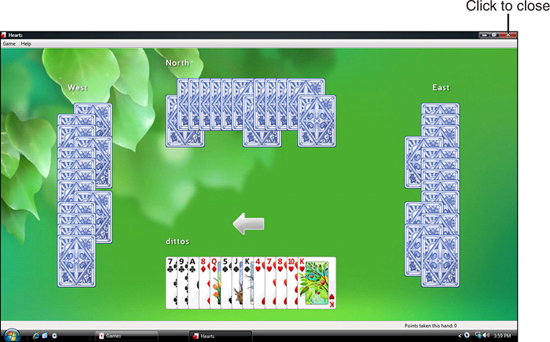
Watch Out!
You will no longer find Internet versions of Hearts, Backgammon, Checkers, Reversi, and Spades in Windows Vista. Unlike Windows XP, Microsoft removed the online, multiplayer versions of these games and you can no longer play Hearts over a network. The games are still available over an Internet connection, however, from the MSN Games website at http://games.msn.com.
Hearts is identical to the real-life card game that’s always played in quartets. Your goal is to get rid of all your cards with the fewest points. You get rid of cards by setting down three cards in the center of the game. These cards are called the trick.
You don’t want the trick because then you must take all 12 cards and the goal is to get rid of all your cards as soon as possible. The person who puts down the highest card of a suit takes the trick.
In addition, you get points when you take tricks that contain hearts and the Queen of spades. The more points you have, the less likely you will win. As in golf, in Hearts, you don’t want the high score! As soon as someone gets 100 points, the game ends and the low score wins.
Hearts has lots of rules that can seem foreboding at first but you’ll get used to them quickly. For example, the person with the 2 of clubs is the first person to add to the first trick. In every fourth hand, no cards are put down in the trick. You will shoot the moon when you collect all the hearts and the Queen of spades, but that’s a good thing because you get zero points for that round and all other players get 26 points each.
Given that the rules are somewhat tricky at first means that playing Hearts on a computer makes things go more smoothly than playing the game with actual cards. The computer monitors the score and makes sure that the rounds go according to rules. You can focus on strategy.
Chess Titans—You Against the Machine
Chess Titans is a traditional chess game where you play against the computer. You can rotate the three-dimensional board to see various views during the play. Figure 11.10 shows a game in progress and white has already lost a queen and a bishop.
Figure 11.10. Play chess against your computer and may the best strategist win.
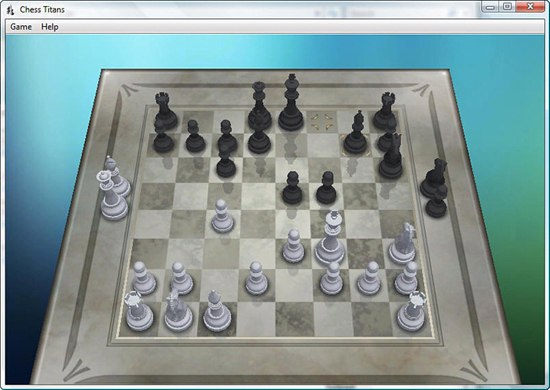
Did you Know?
You can also play against another person by selecting New Game Against Human from the Game menu. After you make a play, the board turns around so that your opponent can use your keyboard to make a move.
This certainly isn’t the place to list the rules of chess but, as with Hearts, your computer monitors the game whether or not you play against another person or the machine, and ensures that all moves are legal. In addition, the computer keeps track of your win record so that you can see how you’re improving over time.
Did you Know?
Chess games can take a while to play. During a game, you can save the board to continue at a later time.
Mahjong Titans—Tosses Tiles to Trick You
Mahjong Titans is an extremely simple and enjoyable game based on an Asian tile game. When you start Mahjong Titans, you’re presented with a series of tile patterns to choose from. After you click to select one, an actual game begins. Figure 11.11 shows the beginning of a game.
Figure 11.11. Point to two matching tiles whose left or right sides aren’t both bound by another tile to remove the tiles.
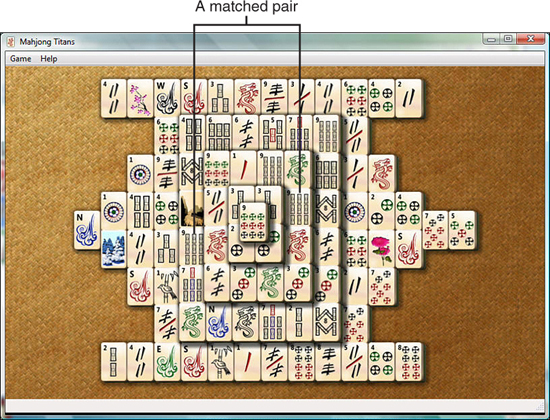
The goal is to get rid of all the tiles. At first, the three-dimensional aspect of the board adds slightly more challenge to the game than will be there after you grow accustomed to the way the board works. As you play, you must always view the tiles like stacks of tiles on a table. The game adds shadowing along one edge of the tiles so you can more easily see which tiles are on top of other tiles.
The goal is to locate two matching tiles and remove them. You select one, and then find its match, and click it to remove both tiles. The only rule is that there must be a left or right edge on each of the matching tiles before you can remove them. If you try to remove a pair and one of them has tiles on both its left and right edges you won’t be allowed to remove the pair of tiles and you must select another matching pair if one is available. You win when you remove all tiles from the stack. You lose if you run out of pairs available to remove.
In Figure 11.11, there are two tiles you can remove. They are the tiles with 9 blocks on them (other moves are possible, too). As you can see, the left one isn’t quite as obvious, at least in the figure where the shadowing effect is somewhat lost, because the left one is stacked on top of the tiles beneath and doesn’t have any tile on its left edge. The tiles that appear to be on its left in the figure actually are on the stack of tiles beneath that level. To remove them, you would point to one then the other and your computer would remove both from the stack. When you remove tiles, you free up additional tiles that were not available for movement before. If a tile has an actual color picture on it (called a season tile in the default game appearance) as opposed to a design or number of some kind, as a few have each game, you can find another color picture and remove both even if they don’t match.
Experience Purble Place
Purble Place is a collection of three games. The style of the games is certainly geared more toward younger audiences than the other games in your Games Explorer window. When you first start Purble Place, a colorful little town scene opens like the one in Figure 11.12.
Figure 11.12. Purble Place opens with a town that acts as the main menu.
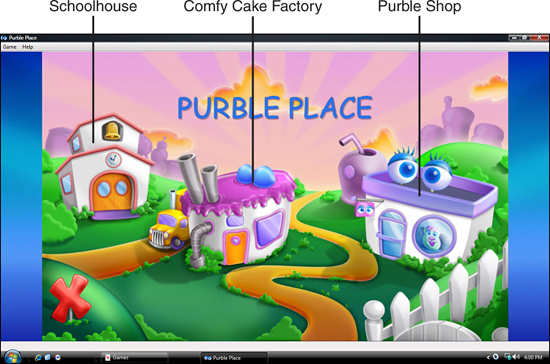
The goal of Purble Place is to help children learn memory skills, colors, and shapes.
Playing Purble Pairs
Clicking the schoolhouse opens a concentration-like game that tests the player’s memory (see Figure 11.13).
Figure 11.13. Purble Pairs tests your memory and concentration.

Players click a square to reveal what’s underneath and that square remains shown until the player displays the contents of a second square. If they both match, they are erased from the board. If they don’t match, the computer covers them up again. You keep clicking pairs of squares trying to recall where a match might be. Keep matching up pairs until you get rid of all the pairs and the game ends.
You can get a sneak peek at all the tiles by clicking on one of the gold tokens in the lower-left section of the game window. Each time you get a sneak peek, a sneak peek token goes away. Occasionally you’ll see a bonus tile with a token in its corner. If you can match a bonus tile with the token showing, you gain another sneak peek gold token to use.
Playing Comfy Cakes
Comfy Cakes is a Purble-based color and shape-training game. You’re presented as a worker in the cake factory. An order comes in for a cake. Look at the picture and try to build the cake that the customer wants.
Figure 11.14 shows the Comfy Cake factory in progress. At each station along the assembly line you must choose the correct shape and color to build the cake shown.
Figure 11.14. As the cake moves down the assembly line, you must put together the correct shapes and colors to build the cake that the customer ordered.
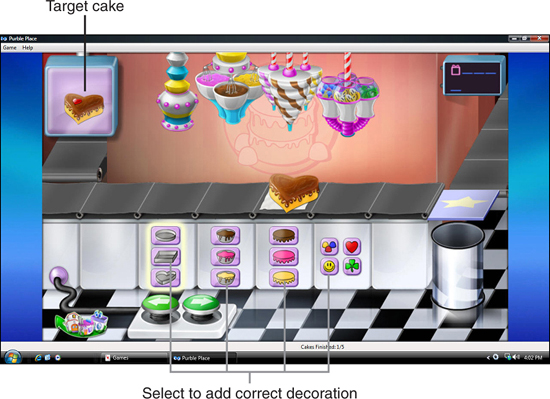
Playing Purble Place
In Purble Place, you actually build Purbles themselves! In a game that’s somewhat like the Comfy Cake game, your charge is to build a Purble. Figure 11.15 shows a game in progress. The game is an extremely loose translation of the traditional board game of Clue.
Figure 11.15. Build Purbles to match the one behind the curtain.
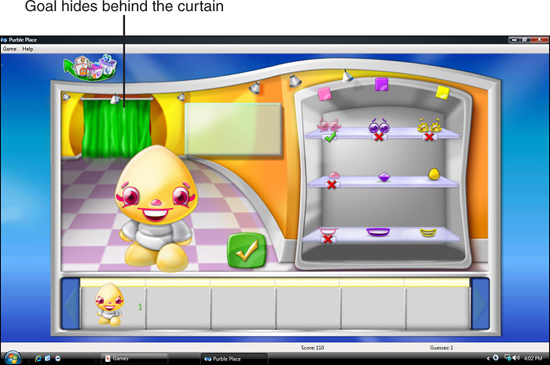
Behind the curtain is a Purble and you must build a Purble to match the one behind the curtain. You’ll select eyes, a nose, and mouth. When you finish adding all three facial features, you click the check mark to see how many you got right. The first time is just a guess, but then you’re told how many of the three parts are correct. You must then deduce which should be changed and how.
Setting Game Parental Controls
The Parental Controls button on your Games window toolbar enables an administrator level user to set controls on who can run games. When you click the button, Vista displays a list of users authorized to use your computer. You click to select a user and Vista displays a window that determines what that user can do on the computer. (Chapter 26, “Separating Users Gives Each the Access They Need,” explains how to set up and manage user accounts.)
Initially parental controls are set to off, but when you click the On option, Vista provides options that you can designate for that user. The user you’re setting control access to cannot have an administrative account because an Administrator can modify all settings on the computer, including parental controls.
Watch Out!
You must have administrative privileges to set and change parental controls for other users.
When you select the Games option, Vista displays the Games Control window shown in Figure 11.16. You can block all games from the account (meaning that you block all games listed in the Games Explorer window, as the next section explains) and you can elect to allow the user to play games that meet a certain rating. This rating, set by the Entertainment Software Rating Board (ESRB), is one generally followed by all major game makers to restrict usage to an appropriate player, just like movie ratings. It ranges from Early Childhood to Adults Only. However, it’s a broad system and you can also restrict games with specific types of content, such as animated blood or intense violence (assuming that Vista recognizes the game or if the game itself is designed to tell Vista what it contains). The highest rating you assign to a user’s account determines the highest rating that user can play on your computer.
Figure 11.16. You can set up user accounts so that they can play games of a specific rating.
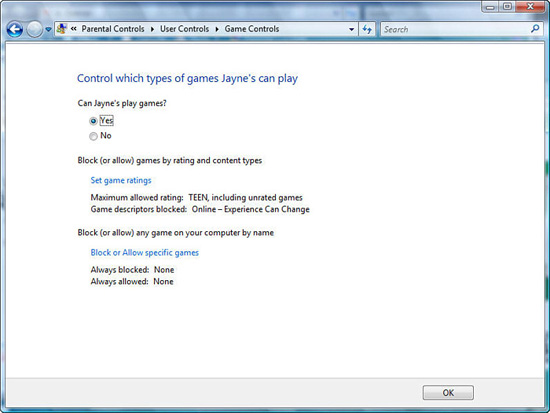
If you click the Block or Allow Specific Games option, Vista will look not just at ratings but also specific games you have installed and monitor the user’s account anytime the allowable and blocked games run. If a game is blocked, Vista refuses to start the game for that user.
By the Way
Chapter 27, “Managing Your Windows Security,” explains more about the parental controls and how to apply them to other areas of computing such as online activity.
Your Games Explorer Window
When you open the Games Explorer window in the Start menu’s right pane, you aren’t actually looking at a specific disk location. Instead, you’re looking at the location of games installed on your computer. Those games will appear in various locations around your hard disk folders.
As you install new games on your computer, most recently released games should automatically appear in Vista’s Games Explorer window. That is, the games are supposed to if the game vendors wrote the games properly for Vista. Some older games or those not written specifically for Vista will still appear in your Games Explorer window because Vista monitors common games and can recognize many of them.
Still, there are sure to be plenty of game titles that, when installed, won’t show up in the Games Explorer window. That doesn’t mean, however, that you can’t get them there. To put a game’s shortcut in the Game Explorer window manually, you need to open both Windows Explorer and Games Explorer. Adjust the size of each window so that you can see both on your screen at the same time without overlapping. In Windows Explorer, locate the folder where you installed the game. Drag the game’s executable file entry to your Games Explorer window. A shortcut moves to the Games Explorer window so that all your games are accessible from one place. To remove a game from the Games window, right-click the game and select Remove from List.
By the Way
A game must appear in your Games Explorer window before you can set parental controls for the game.
Chapter Wrap-Up
This chapter gave you a break from the mundane by showing you the games that come with Microsoft Vista. By utilizing a single repository for all your games, Microsoft ensures that you can control access to every game installed on your computer. The Games Explorer window should contain an entry for each game on your computer. Not only will the Vista-installed games appear, but also the games you install from outside sources.
In the next chapter, you get help on help! You’ll learn all the ways that Vista offers to help you through problems and the locations where you can find information on just about any topic related to Vista. Vista’s help system goes far beyond that of a traditional program’s online help system, as you’ll see.
